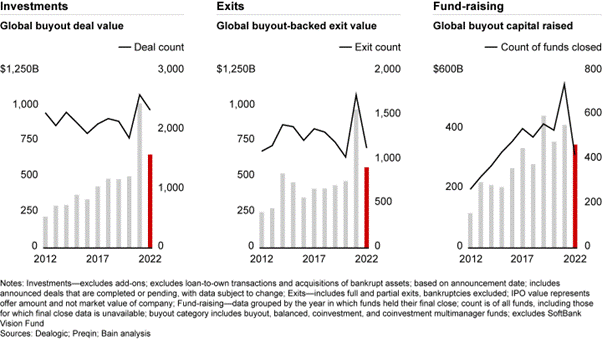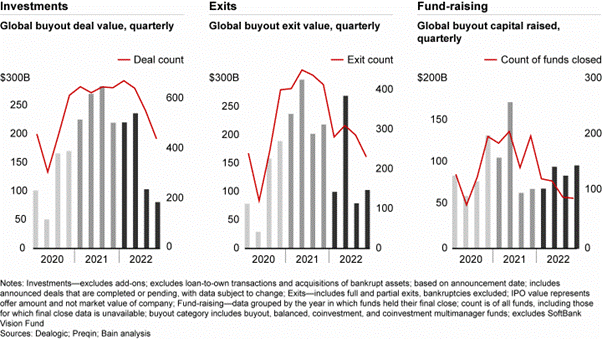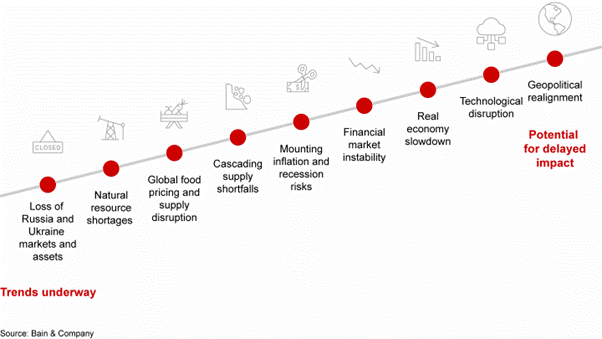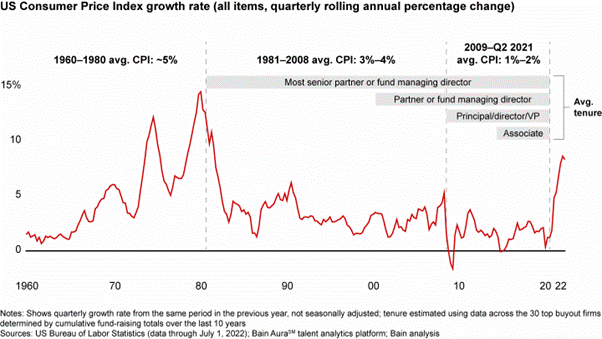Private equity outlook in 2023: Anatomy of a slowdown

As extraordinary and resilient as the post-Covid rally in global private equity proved to be, it was ultimately no match for the Fed, according to Bain & Company’s latest annual Global Private Equity Report.
For the first six months of 2022, the industry extended 2021’s record- shattering burst of deal activity, despite persistent inflation, the invasion of Ukraine, and growing tensions with China. Then, in June, when US central bankers issued the first in a series of three-quarter-point interest rate hikes—and their colleagues around the world followed suit—banks pulled back from funding leveraged transactions and dealmaking fell off a cliff, pulling exit and fund-raising totals down with it (see Figure 1).
shattering burst of deal activity, despite persistent inflation, the invasion of Ukraine, and growing tensions with China. Then, in June, when US central bankers issued the first in a series of three-quarter-point interest rate hikes—and their colleagues around the world followed suit—banks pulled back from funding leveraged transactions and dealmaking fell off a cliff, pulling exit and fund-raising totals down with it (see Figure 1).
Given the heights from which they fell, buyout deal value ($654 billion), exits ($565 billion), and fund-raising ($347 billion) all finished 2022 with respectable totals in a historical context (see Figure 2). But the sudden reversal marked the end of an up cycle that has endured (with a brief Covid brake tap) since 2010, when the industry emerged from the global financial crisis and produced a 12-year run of stunning performance.
Figure 1

Figure 2

It remains to be seen whether the abrupt shift from accommodation to tightening will trigger what could be called the most anticipated recession in history that hasn’t happened yet—at least not in the US. A tight labor market and lingering Covid-related stimulus have so far kept the economy limping along. (The fleeting two-quarter dip in 2022 wasn’t officially deemed a recession.)
Yet there’s no denying the impact of the unprecedented mix of macro forces in play (see Figure 3). The resulting rise in rates has already shut off the spigot of cheap, obtainable debt financing. And deep ambiguity about the future course of global economic activity is likely to cast a shadow over the private equity value chain through 2023’s first half, if not beyond.
Figure 3

What makes the current economic slowdown different from the one brought on by the global financial crisis is the lack of clarity about what’s happening. There’s no Lehman collapse, no housing meltdown, no sharp falloff in economic activity to signal a definitive sea change. Instead, the global economy is presenting investors with conditions few among them have ever seen before. As if war in Europe, energy shocks, and supply chain issues weren’t enough, inflation hasn’t been this high or persistent in 40 years (see Figure 4). The resulting rise in interest rates has reversed a downward trend that has defined investment markets for as long as anyone can remember.
Figure 4

The net result is the dreaded “U word”—uncertainty, a deal killer if there ever was one. As buyers, sellers, and lenders all wait for clarity around the economic forces that could affect cash flows, uncertainty will continue to act as a cap on deal activity, especially for the largest transactions that require the most leverage. Dealmakers are still finding ways to finance smaller transactions with private credit and larger equity infusions. But the overall decline in new deals and exits will likely persist, creating a knock-on effect for fund-raising.
Limited partners (LPs) will need time to work through imbalances in their portfolios brought on by market swings and a slowdown in cash back from previous commitments. The short-term cash squeeze will make it difficult for them to extend new commitments, especially after several years of record-breaking allocations to private equity. Raising new capital will be particularly hard for midsize generalist funds as LPs continue to favor specialists and large funds with top-tier performance. The same could be said for general partners (GPs) challenged to generate distributions because their exit volume is dependent on the (now-moribund) market for initial public offerings.
How long these conditions will last is impossible to predict with any accuracy. But amid the short-term gloom, there is nothing to suggest the long-term outlook for private capital is any less positive than it was in 2021. Indeed, after attracting an astonishing $10.7 trillion in capital over the last decade, the industry may be getting even more appealing as investors continue to chafe at the limitations of the public markets.
Read the rest of this article here on bain.com, and explore Bain’s full Global Private Equity Report 2023 here. Bain & Company is a principal consultant sponsor of SuperReturn International. Make sure you join them in June in Berlin.